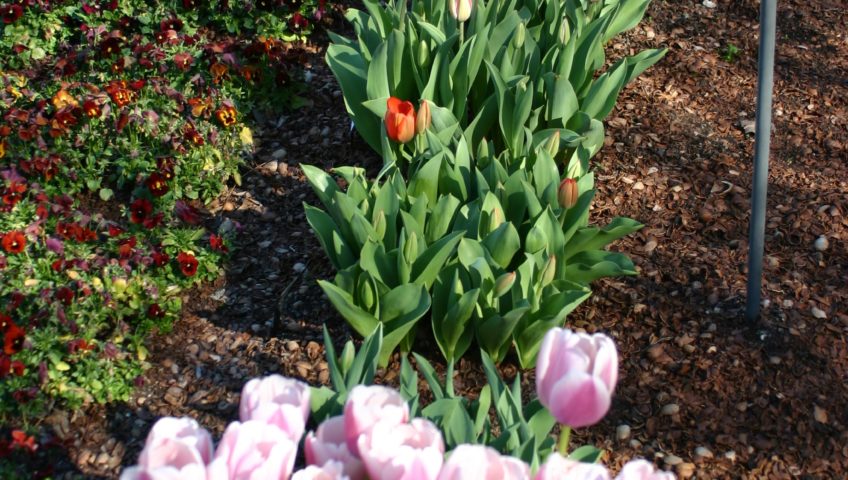We want to show you how annuals can make your Flower Mound property beautiful.
Why Annuals?
Annuals are abundant, easy to plant and care for. Plus, there’s such a wide variety of them available that you can add variety and interest to your landscape, porches, patios, and borders three seasons of the year. As a matter of fact, Texas A&M’s extension service recommends changing your annuals in the beginning of each season because early spring plants will not do well during our hot summer months. Meanwhile, change out spent summer annuals in early fall to add some zip with bold fall colors. Here are the three annual planting times that the extension service recommends:
From late February through early June: Plant spring annuals such as African daisy, annual phlox, blue lobelia, coleus, impatiens, petunias, sweet alyssum and vincas.
From June through early September: Enjoy alyssum, bachelor buttons, begonias, coleus, geraniums, pentas, salvia, and sweet potato vine.
From late September through October: Take out your tired annuals and replace them with some pop like colorful cabbage and kale, pansies, and violas.
Grow Great Annuals
You can have gorgeous annuals throughout the entire growing season in Flower Mound, TX. Here are 10 tips to successfully plant, maintain, and show off your beds, borders, and containers with annuals this year:
1. Prepare your soil: The secret to growing great plants, including annuals, is to have healthy soil. To see if your soil has the right nutrients and pH balance for planting, have your soil tested. To buy a soil test and find a lab, contact your local extension service, http://agrilifeextension.tamu.edu/.
2. Add some fertilizer: Fertilizer feeds your plants to keep them blooming throughout the season. To learn more about fertilization for your landscaped beds, go to http://aggie-horticulture.tamu.edu/extension/homelandscape/annual.html.
At Main Street Mowing, we recommend an organic, slow release fertilizer that you can find in big box stores or garden centers. Apply this granular fertilizer every eight weeks to your landscaped beds and borders to give them a boost of nutrition.
3. Mix in some weed control: When you’re ready to plant your annuals, add some pre-emergent weed killer specifically manufactured for ornamental plants.
4. Timing is everything: When it comes to planting any flowers, realize that timing is everything. Make sure any threat for frost is past and the soil is 70°F. This is the time to pull any annuals that have reseeded from the year before. These seedlings will look bland and leggy compared to flowers you just bought from a nursery or garden center.
5. Handle with care: Make sure you have a design in mind. Don’t feel that you have to go in the typical straight rows, but experiment with shapes like teardrops, ovals, and planting in odd numbers rather than even. You want to draw the eye to your beds with their colors and textures. And don’t forget to add a focal point to your garden design.
After you have a plan in mind, lightly irrigate the plants while they’re still in their containers to loosen up the soil as well as irrigate the plants. A light tap on the bottom of the containers will usually bring the plants out. If roots are really tight in the containers, gently take a knife around the container’s edges to loosen the plants to slip out for planting. If your plants are in peat pots, thoroughly soak them in water for 10-15 minutes. Then place the plant and the peat pot directly into the soil.
6. Mulch is not just for pretty: Yes, when you add mulch you’re putting the finishing touches on your landscape beds and borders. But mulch also provides moisture retention, regulates plant temperatures, and keeps weeds at bay. Make sure that you use an organic mulch such as bark chips, pine needles, or hulls.
7. Irrigate properly: For your lawn, we recommend a deep soaking on an irregular basis. The same principle holds true for your landscaped beds. A good, deep soaking will allow water to absorb deep into the ground. Likewise, it’ll encourage your flowers’ roots to grow deeply too. So when there’s a dry spell, your plants will be able to take moisture from the deep soil reserves. Also, don’t spray water directly on plants’ foliage because it’ll encourage fungal growth. It’s always best to water your gardens and borders early in the morning so water doesn’t stay on the plants but has enough time to dry off.
8. Upkeep: Most annuals require very little TLC. However, there are some annuals, like African daisies, begonias, impatiens, and geraniums that need to be deadheaded on a regular basis. You can cut dead flowers off with a scissors or by hand.
9. Diseases, insects, and other pests: Powdery mildew, aphids, white flies and spider mites may plague some of your annual flowers. Those flowers that are susceptible to powdery mildew, such as zinnias and calendulas, may need a fungicide.
10. Weeds: If you happen to have some weeds survive through the pre-emergent herbicide and mulch, gently hand pull them, taking care not to pull out your annuals.
We’re lucky to live in northeastern Texas where we can change our annuals up to three times a year for a wide variety of color and interest.
If you’re busy tending your annuals and other landscaped plants in Flower Mound, Highland Village or Lewisville, and don’t have time to mow your lawn, call us at 214-317-8301 or chat with us at https://mainstreetmowing.com/.
Resources:
Better Homes & Gardens. Plant Encyclopedia: http://www.bhg.com/gardening/plant-dictionary/.
Johnson, Dr. William, M. “Good Soil is Crucial to Successful Gardening,” Texas A&M: http://aggie-horticulture.tamu.edu/galveston/good_soil_is_crucial_to_successful_gardening.htm.
Martin, Jim. “Planting Annuals,” East Texas Gardening: http://easttexasgardening.tamu.edu/tips/flowers/plantAnnuals.html.
McGee, Joe Helen. “Planting Annuals,” East Texas Gardening: http://easttexasgardening.tamu.edu/tips/flowers/plantAnnuals.html.
Wilkerson, Don. “Seasonal Care…Care and Management,” Texas A&M Extension: http://aggie-horticulture.tamu.edu/extension/homelandscape/annual.html.
